Widely regarded as the “Father of the Op Art movement," French-Hungarian artist Victor Vasarely became entranced by patterns, including that of a chessboard in the late 1930s, which became the quintessential framework for his art.
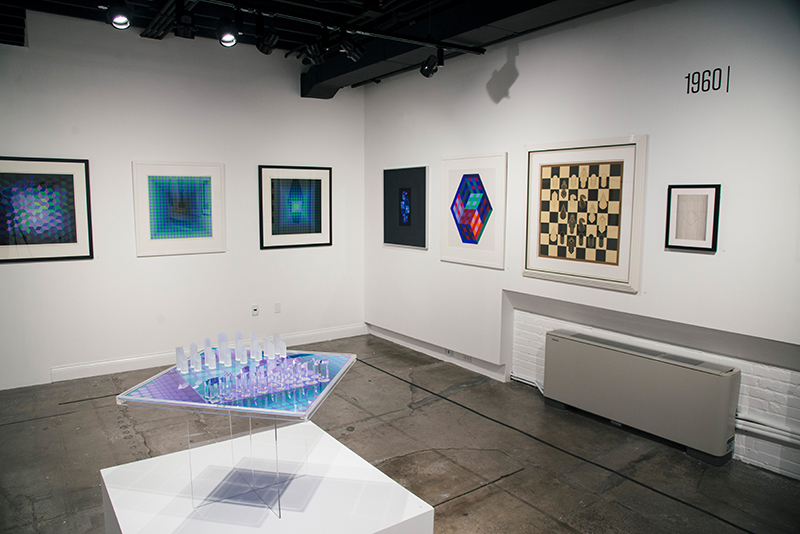
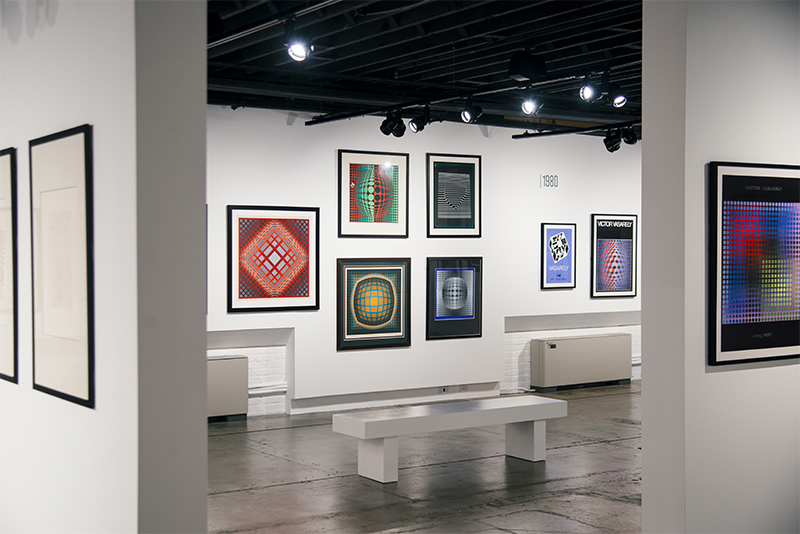
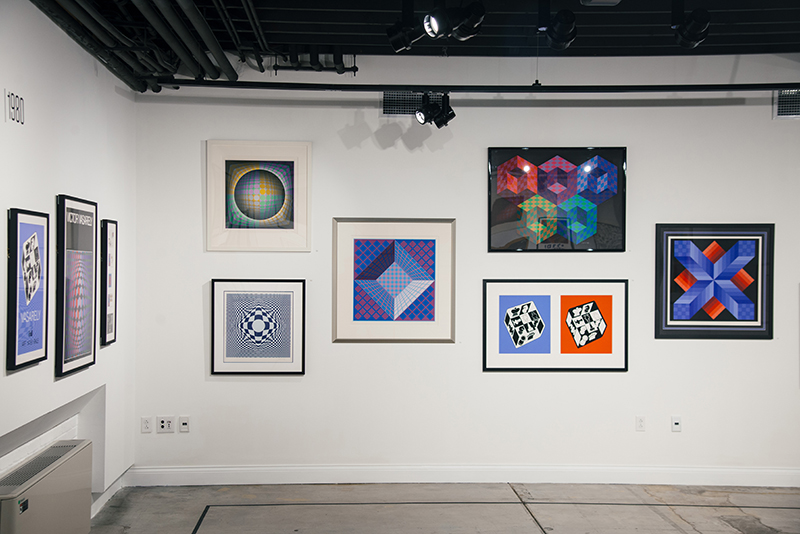
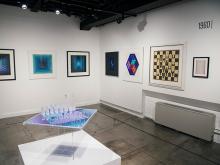
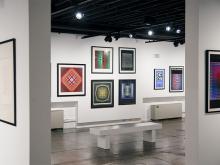
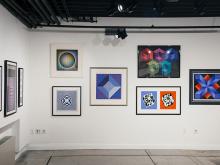
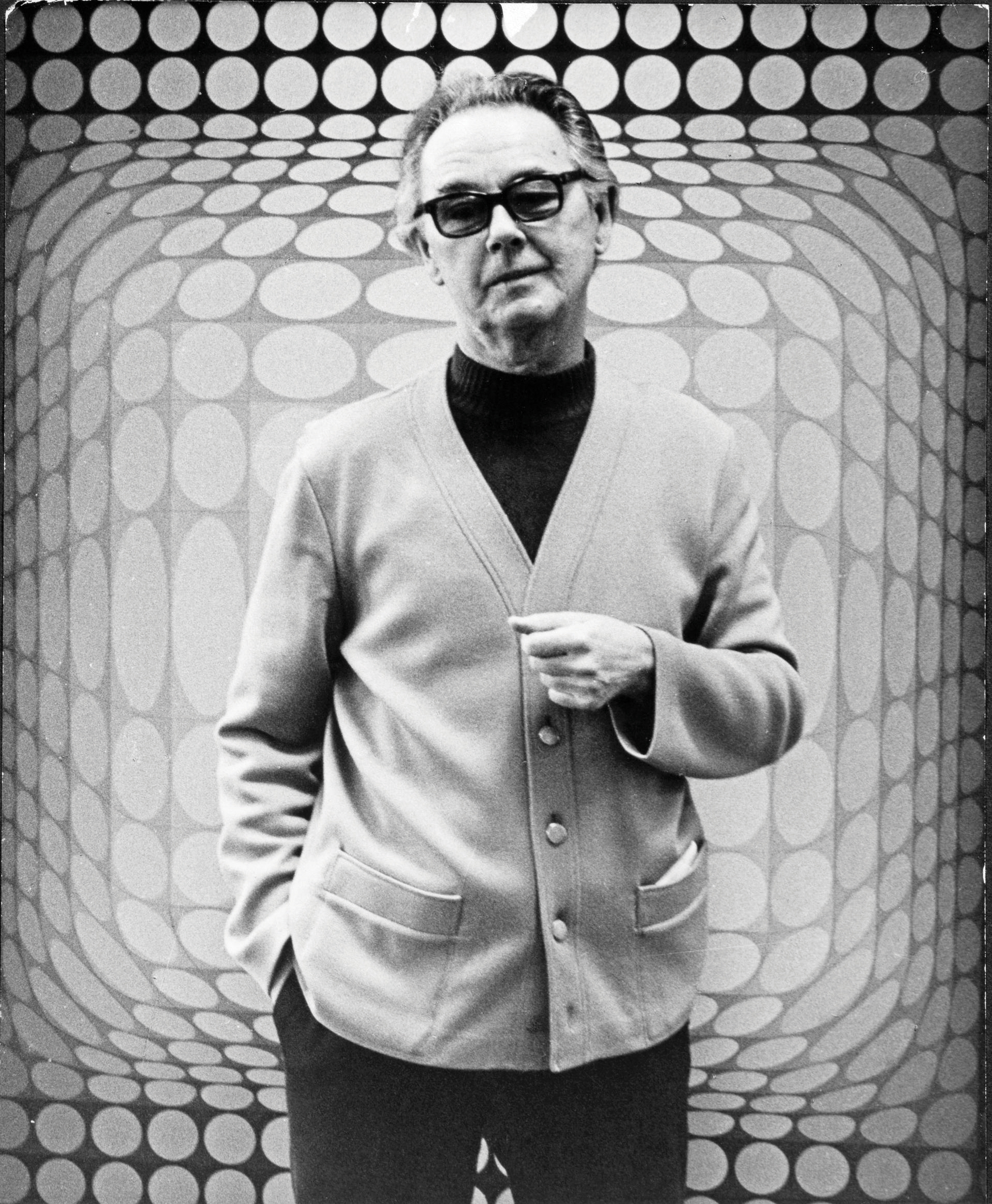
“Op Art,” short for Optical Art, was coined by Time Magazine in a 1964 review of the exhibition Julian Stanczak: Optical Paintings at the Martha Jackson Gallery in New York City. Arguably the father of this innovative and futuristic movement was actually the Hungarian-French artist Victor Vasarely, who had been experimenting with the rhythm of colors and shapes for decades.
Born in 1906, in Pecs, Hungary, Vasarely initially studied medicine, then turned his focus to art. His love of abstraction began in 1929-30 at the prestigious Mühely Academy in Budapest—a center for the new influential Bauhaus movement of modern design that was spreading throughout Europe. Immediately upon graduation, Vasarely had a solo exhibition at the Kovaks Akos Gallery in Budapest and soon after relocated to Paris to work in graphic design at the Havas advertising agency. For the next decade, in addition to creating some figural work and experimenting in the Surrealist movement, he began playing with concepts that would go on to be the basis of his signature artistic creations—optical illusions.
Through his exploration of composition, color, light, medium, dimensionality, and linear networks, Vasarely created his well-known zebra, tiger, and, most apropos, his checkerboard patterning in his “Graphic Period” (1929-1946). Though it is not discussed whether he was a chess player, Vasarely began incorporating chess imagery—boards, crowns, and pieces—into his chess-related artworks. Through the arrangement of perpendicular line, Vasarely manipulated shape and the placement of color to create a rhythm or visual vibration.
Vasarely believed in creating art that could be a part of everyday life. This conviction became even more apparent after his brief stay in Belle-Isle, a French island off of the coast of Brittany. Vasarely said that his time there “had a strong and lasting effect on me…I observed the forms Belle-Isle presented to me, all of which could be traced back to ellipses and ovoids…In the morning the clouds took on the form of pebbles…Even the setting sun was distorted and became elliptical.” The work Vasarely produced that was inspired by this time is called his “Belle-Isle Period” (1947-1958) because it marked the debut of his interest in irregular organic geometric forms.
Concurrently engaged in multiple stylistic movements, Vasarely entered into his “Denfert Period” (1951-1958). He often recounted that his stylistic development did not necessarily represent a linear evolution in his work; he repeatedly reworked or revisited earlier works in later decades. For example, inspired by the cracked tiles in the Paris Métro station Denfert-Rochereau, Vasarely claimed to have seen “strange landscapes” or “ruins of vanished great cities.”
All the while, Vasarely continued to engage with his fascination with depth perception and spatial distortion, leading him to the phase of his career that most emphasized optical illusion. In his “Black and White Period” (1950-1965), his works were drawn from photography and its positive/negative nature. Taking identical blown-up images of his black and white artworks, Vasarely would then mount them on Plexiglas and lay them on top of each other. By shifting the plates slightly a vibrating field would emerge. As the viewer moved in front of the piece, the image would transform, making the viewer an active part of the artwork. This laid the foundation for Vasarely’s late work: “an art for all,” according to the artist, an art that the viewer could appreciate without the knowledge of art history or art making and an art in which the final image is the product of the viewer’s own eye without contemplation. As Vasarely stated:
What is at stake is no longer the ‘heart’ but the retina, and the connoisseur has now become a study object for experimental psychology. Harsh black-and-white contrasts, the unbearable vibration of complementary colors, the flickering of linear networks and permutated structures…all these are elements in my work whose task is no longer to plunge the viewer into a sweet melancholy but to stimulate him.
This late work became his biggest contribution to the Op Art movement and his own legacy: “unite plastique/plastic unit”—also known as “The Plastic Alphabet.” The principle behind this pictorial unit was actually quite simple. Vasarely took a 10 x 10 cm colored square, into which a differently colored geometric figure was inserted, such as a smaller square, a rectangle, a triangle, a circle, an ellipse, etc. Through the use of six chosen colors (initially chrome yellow, emerald green, ultramarine blue, cobalt violet, red, and grey), the pictorial unit, based on the contrast between black/white and positive/negative, could potentially be produced in an infinite number of variations. The resulting “plastic alphabet” of art would make possible the mass production of works of art—a concept reflected in the processes of 1960s Pop artists such as Andy Warhol and Roy Lichtenstein.
The next two decades became the most productive period for Vasarely as his popularity and reputation exploded. He began revisiting some of his earlier themes, demonstrating that the trajectory of his work cannot be traced linearly by theme or period. What is quite different in these new works, such as "Hommage à l’hexagone," is Vasarely’s addition of the Necker's or Kepler's cube and the axonometric cube to his works. The Necker's cube is a hexagon with parallel lines added to create a three-dimensional cube. The axonometric cube is formed by dividing an equilateral hexagon into three identical rhombuses. Both of these cubes create a visual trick where the cube can switch between being perceived as concave and convex. These cubes are often used in optical illusions.
In addition to experimenting with these polyhedra, Vasarely looked back to his chessboard works in his Vega series which was named for the brightest star in the constellation of Lyra and the fifth brightest star in the night sky. In this series, Vasarely began manipulating the lines of the square to create the illusion of bulges and depressions in perspective distortion. Arguably his signature works, Vasarely continued to create variations on this theme until his death at the age of 90 in 1997 in Paris.
Between 1978 and 1982, Vasarely designed a dynamic chess set and board that exemplified his signature Op Art style. The oppositionally translucent and transparent pieces underscore his illusionistic methods, as the light playing off the different pieces is received by the unique sensory perception of each viewer. While not truly kinetic art—a work of art that involves actual movement—Vasarely’s chess set, like his earlier Op Art, creates the potential for the illusion of movement within a specified field that takes place in the viewer’s unique optical experience. With a mission to celebrate the game of chess and its historical cultural significance, the World Chess Hall of Fame seeks to bring the game to the masses—just as Vasarely wanted to do with art. Despite the fact that many of our audience and fans are expert chess players, we strive to create programming that any visitor could relate to, regardless of their level of chess knowledge—and in turn become admirers of the game. This connection makes Victor Vasarely: Calculated Compositions a perfect celebration of art, the game of chess, and innovative thinking.
—Shannon Bailey, Chief Curator, World Chess Hall of Fame
Chess Set
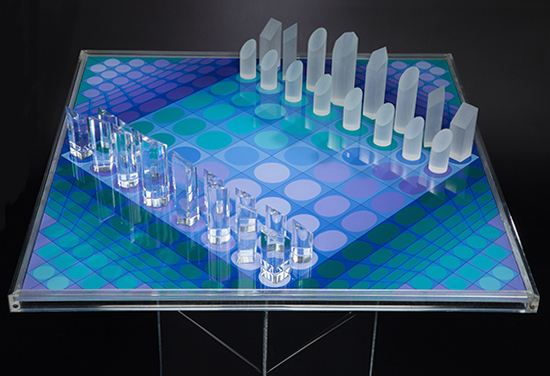
Victor Vasarely
A Perplexus Chess Set and Board, Edition 210/1500
1978
King size: 5 x 1 ½ in.
Board: 28 ⅛ x 28 ¼ in.
Cast resin and color screenprint laminated on acrylic
Collection of Dr. Jeanne and Rex Sinquefield
1930s
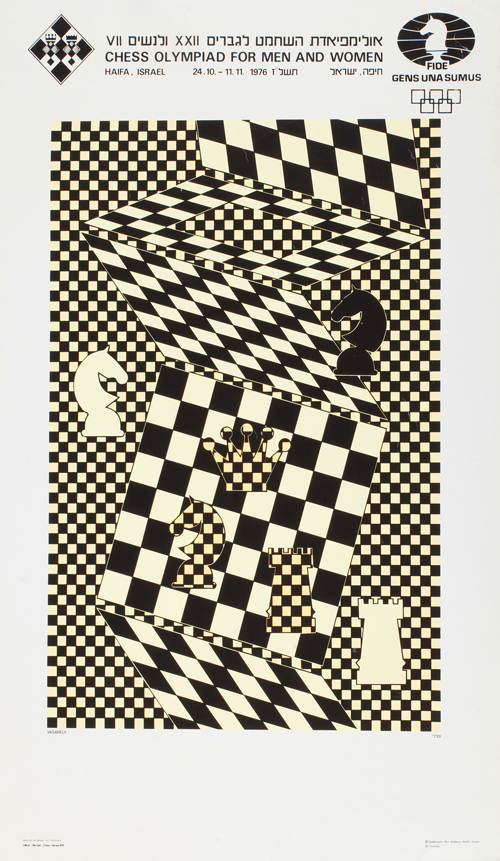
L’Echiquier (Poster from the 1976 Haifa, Israel, Chess Olympiad for Men and Women)
1976, created in 1935
21 ¾ in. x 35 in.
Poster
Collection of the World Chess Hall of Fame
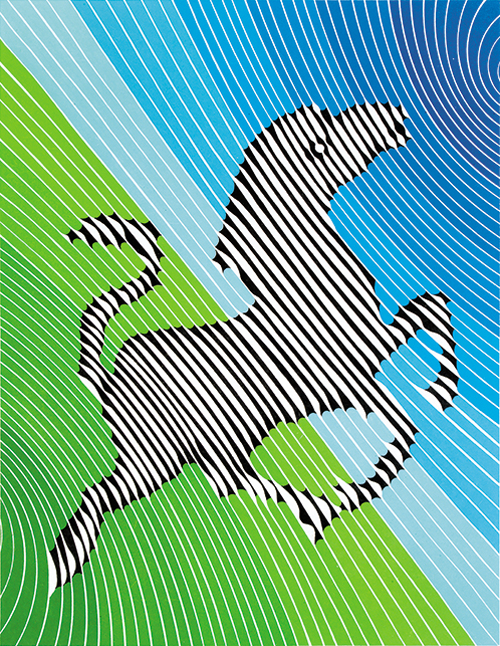
Zébre-B
1984, created in 1936
Serigraph
17 ¾ x 13 ¾ in.
From the collection of Herakleidon Museum, Athens, Greece
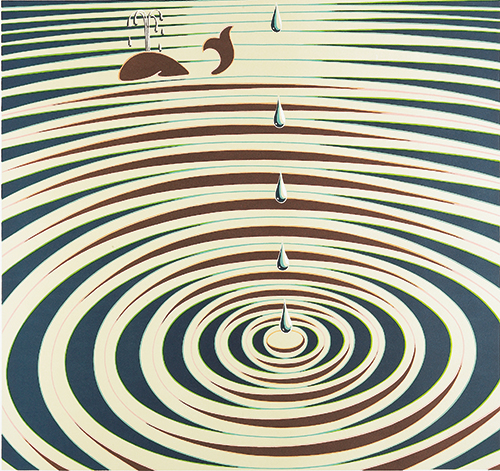
Anneaux-Etude de Mouvement (portfolio Origines?)
1986, created in 1939
Serigraph
17 ¾ x 18 7⁄8 in.
From the collection of Herakleidon Museum, Athens, Greece
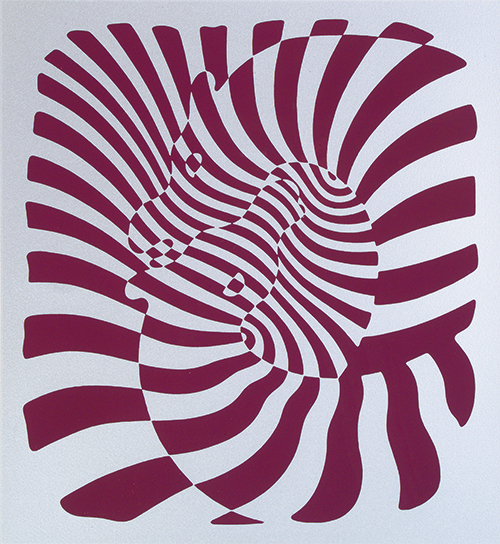
Zébres, edition 172/200
1965, created between 1938-1942
Serigraph
15 x 13 ¾ in.
From the collection of Herakleidon Museum, Athens, Greece
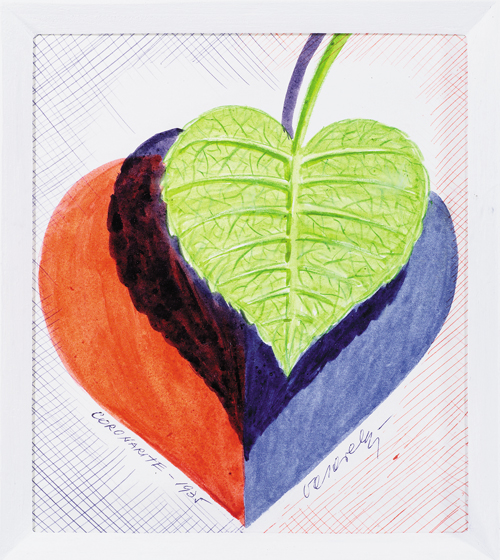
Coronarite
1935
Ink and gouache on paper
6 7⁄8 x 5 15⁄16 in.
From the collection of Herakleidon Museum, Athens, Greece
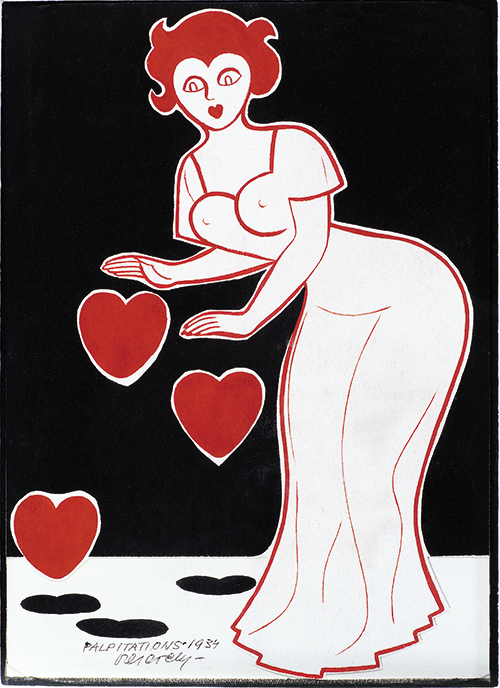
Palpitations
1934
Gouache on paper
9 15⁄16 x 6 9⁄16 in.
From the collection of Herakleidon Museum, Athens, Greece
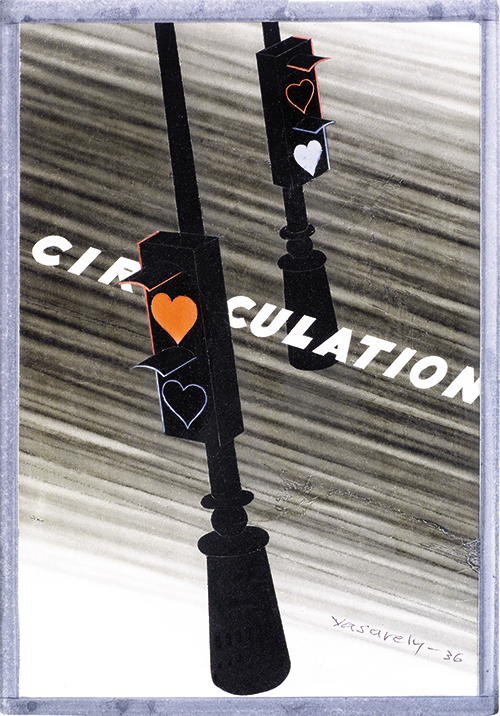
Circulation
1936
Gouache on paper
7 ½ x 5 1⁄8 in.
From the collection of Herakleidon Museum, Athens, Greece
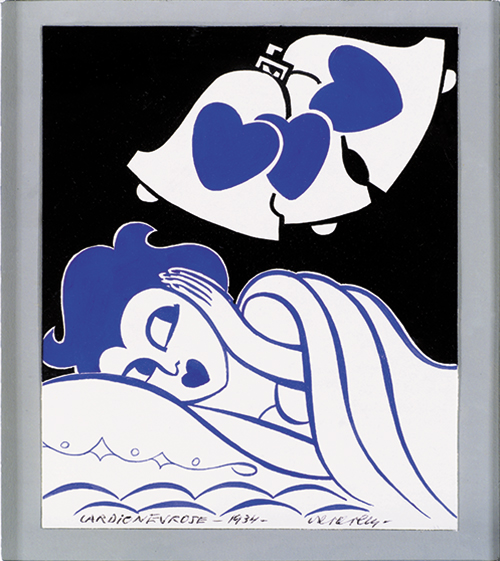
Cardionévrose
1934
Gouache on paper
5 11⁄16 x 4 11⁄16 in.
From the collection of Herakleidon Museum, Athens, Greece
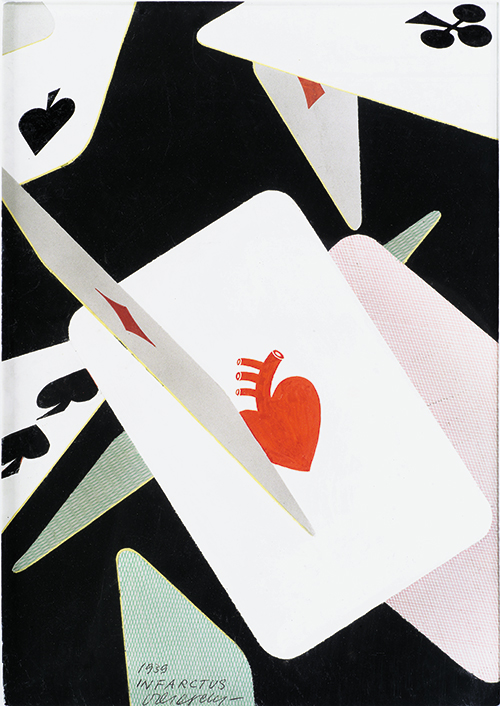
Infarctus
1939
Gouache on paper
9 5⁄8 x 6 11⁄16 in.
From the collection of Herakleidon Museum, Athens, Greece
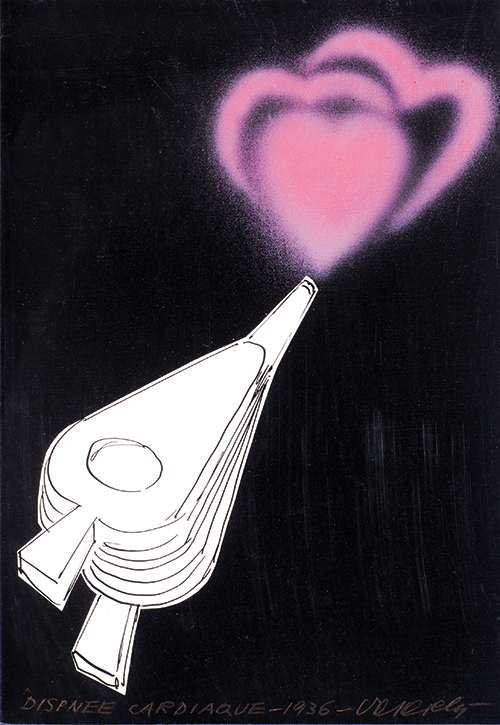
Dispnée Cardiaque
1936
Gouache on paper
7 13⁄16 x 5 7⁄16 in.
From the collection of Herakleidon Museum, Athens, Greece

Fatigue
1934-1936
Ink on paper
23 ¼ x 15 9⁄16 in.
From the collection of Herakleidon Museum, Athens, Greece
1940s
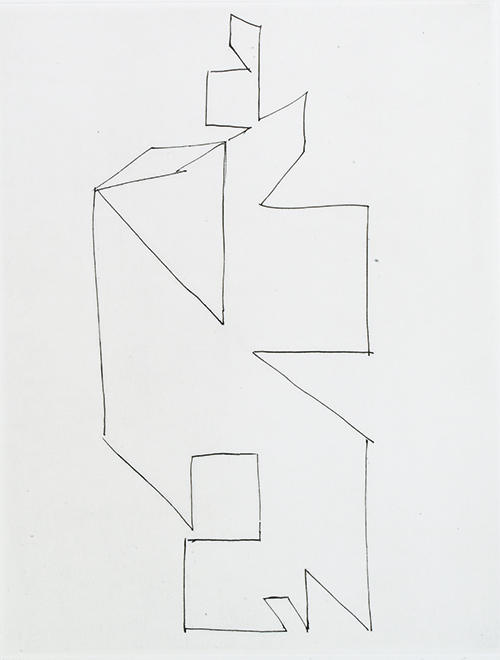
Gordes Synthèse (from Album Gordes, 1971), edition 135/250
1971, created in 1948
Etching
15 1⁄8 x 11 ¾ in.
From the collection of Herakleidon Museum, Athens, Greece
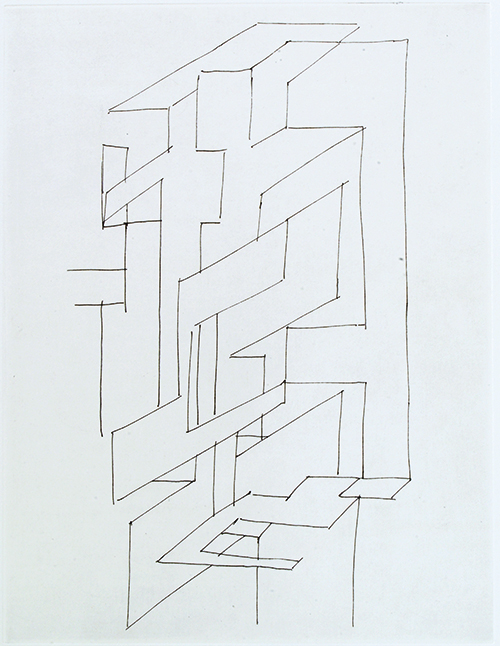
Gordes Gestalt (from Album Gordes, 1971), edition 135/250
1971, created in 1948
Etching
15 1⁄8 x 11 11⁄16 in.
From the collection of Herakleidon Museum, Athens, Greece
1950s
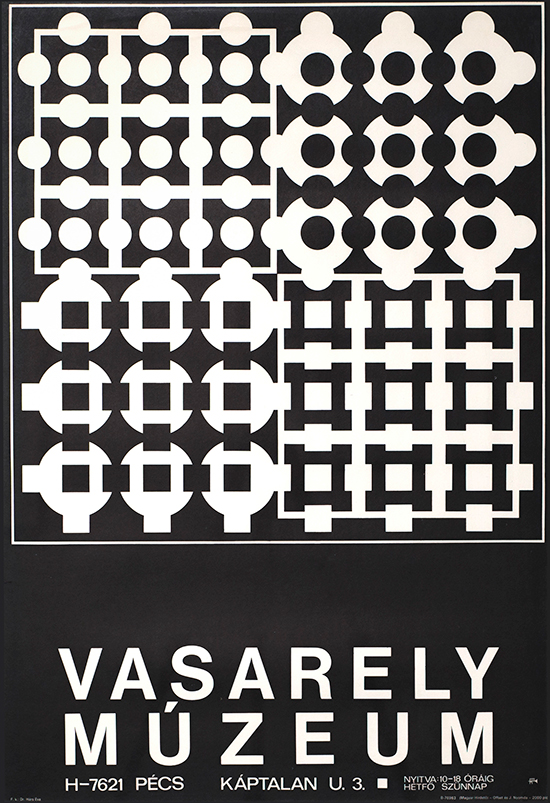
Expo Vasarely Museum
Date unknown
34 1/2 x 24 3⁄8 in.
Paper on cotton canvas
Collection of the World Chess Hall of Fame
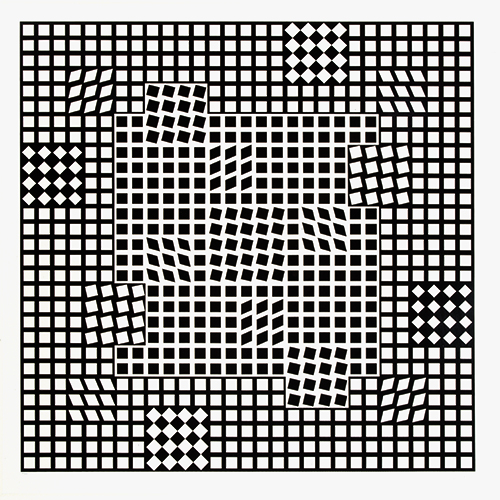
Tlinko-F, edition 40/250
1975, the Tlinko series were painted between 1956-1962
Serigraph
26 15⁄16 x 26 15⁄16 in.
From the collection of Herakleidon Museum, Athens, Greece
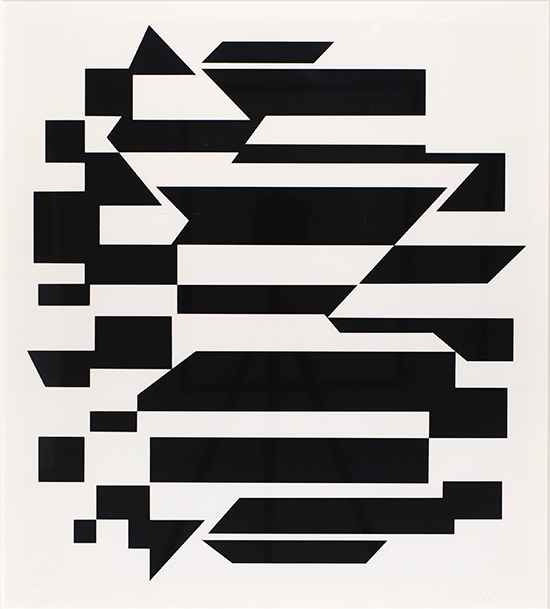
Sipontum K, edition 40/250
1975, after the painting of 1952
Serigraph
27 ¾ x 24 11⁄16 in.
From the collection of Herakleidon Museum, Athens, Greece
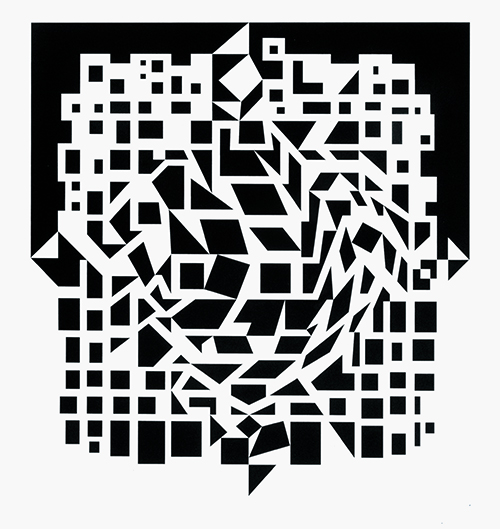
Citra, edition 40/250
1975, after the painting of 1957
Serigraph
27 ¾ x 25 ¾ in.
From the collection of Herakleidon Museum, Athens, Greece
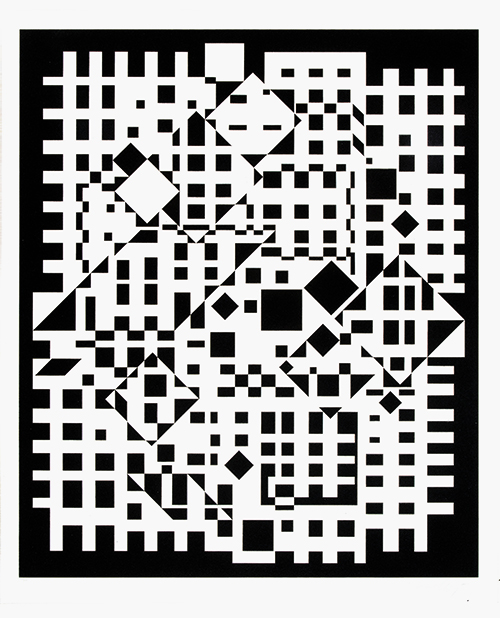
Cintra-Neg, edition 40/250
1975
Serigraph
27 ¾ x 23 ¼ in.
From the collection of Herakleidon Museum, Athens, Greece
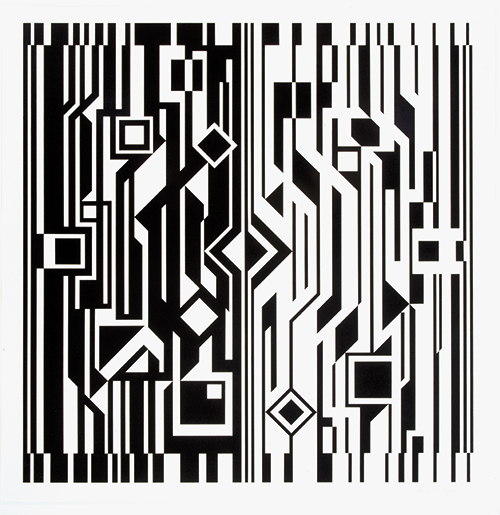
Gizeh, edition 40/250
1975
Serigraph
27 ¾ x 27 ¾ in.
From the collection of Herakleidon Museum, Athens, Greece
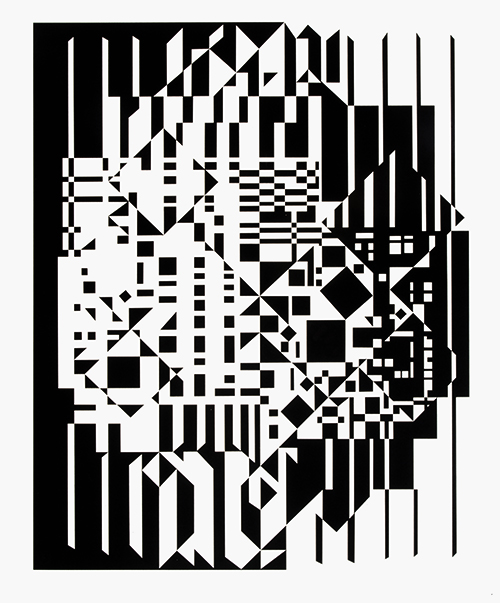
Syrom, edition 40/250
1975, after the painting dated 1956-1959
Serigraph
27 9⁄16 x 23 5⁄16 in.
From the collection of Herakleidon Museum, Athens, Greece
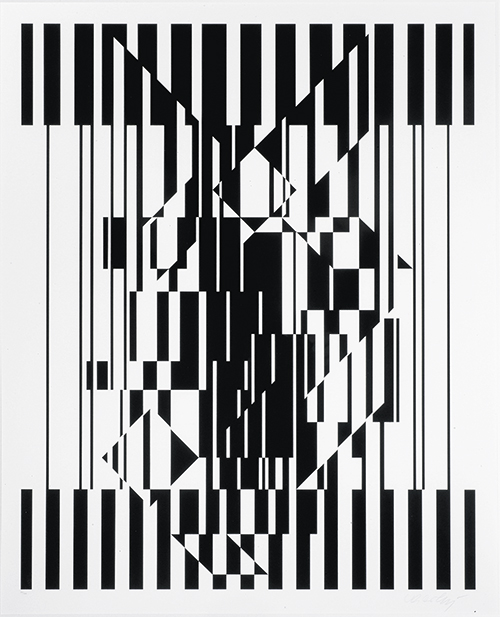
Calcis
1975, after the painting of 1956
Serigraph
27 ¾ x 22 7⁄16 in.
From the collection of Herakleidon Museum, Athens, Greece
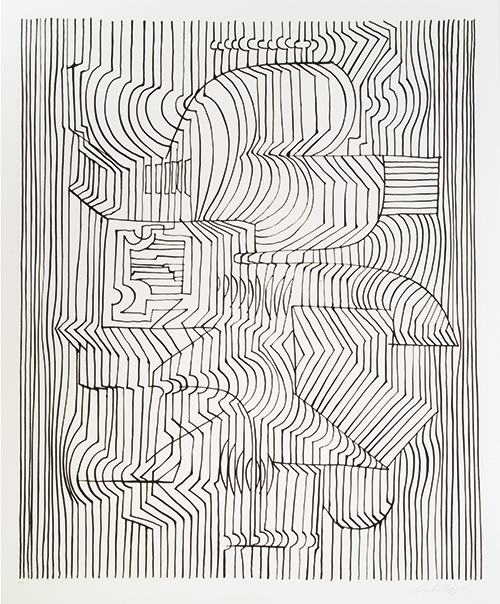
Gordium, edition 40/250
1975, after the painting Gordium PS Positif of 1951
Serigraph
27 ¾ x 22 13⁄16 in.
From the collection of Herakleidon Museum, Athens, Greece
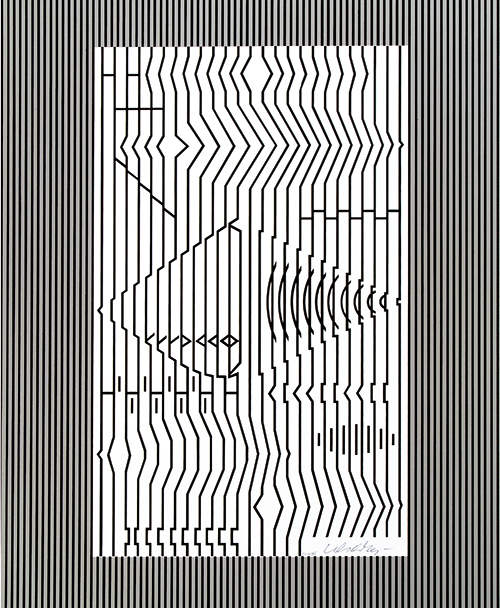
Cithare (Photographisme), edition F.V. 62/75
1982, created in 1958
Serigraph
23 5⁄8 x 15 ¾ in.
From the collection of Herakleidon Museum, Athens, Greece
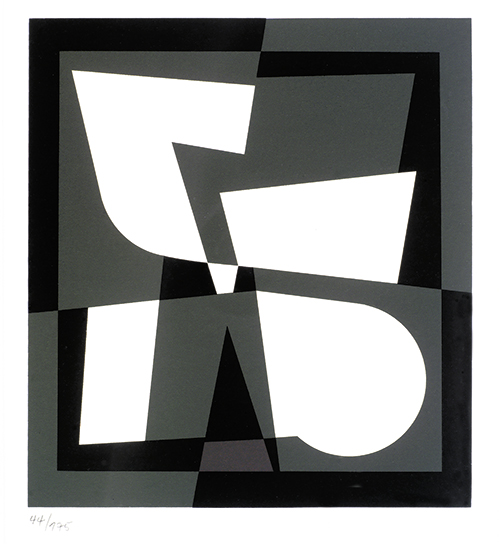
Cingsha, edition 44/175
1988
Serigraph
7 15⁄16 x 6 11⁄16 in.
From the collection of Herakleidon Museum, Athens, Greece
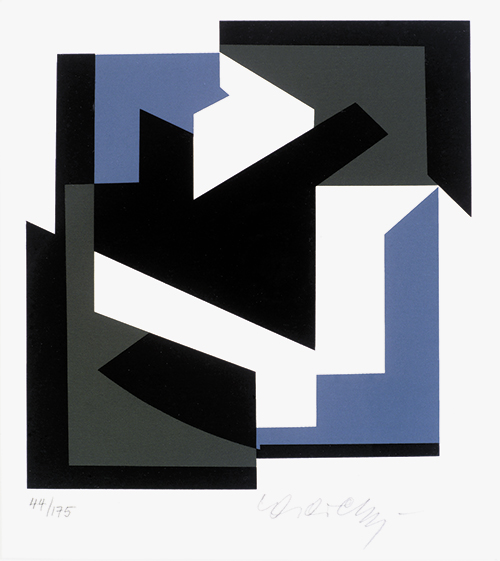
Olbio II, edition 44/175
1988
Serigraph
7 x 6 11⁄16 in.
From the collection of Herakleidon Museum, Athens, Greece
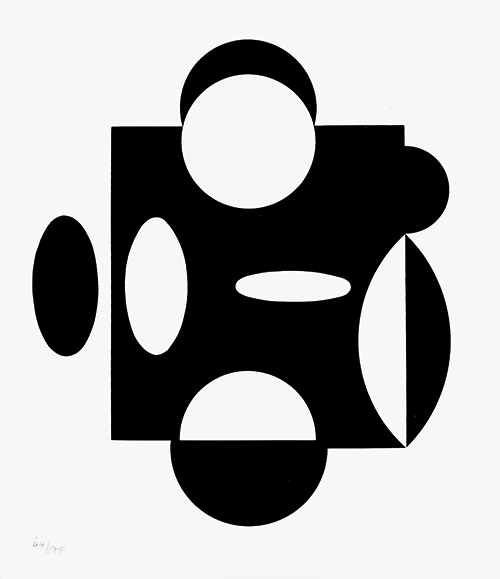
Terreur, edition 44/175
1988
Serigraph
7 7⁄16 x 6 11⁄16 in.
From the collection of Herakleidon Museum, Athens, Greece
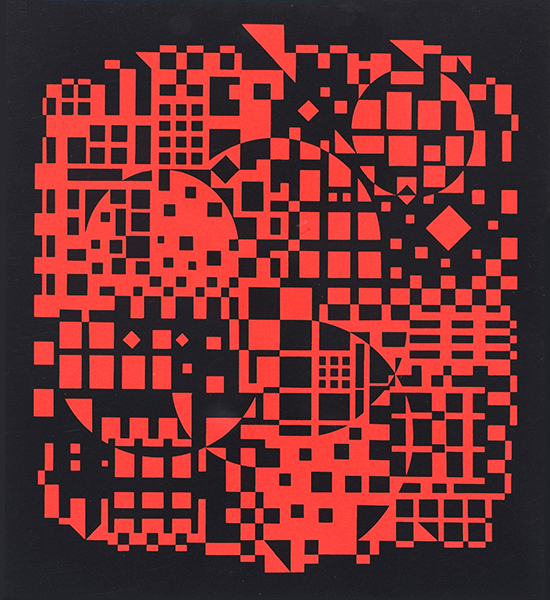
Sikkaso, edition 44/175
1988, after the painting of 1956
Serigraph
7 7⁄16 x 6 11⁄16 in.
From the collection of Herakleidon Museum, Athens, Greece
1960s
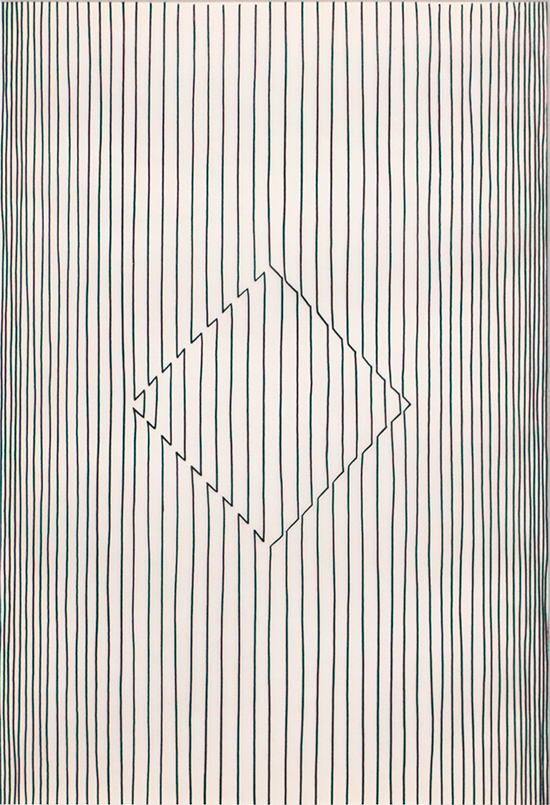
Galerie der Spiegel
Naissances, edition of 450
1963
11 ¾ x 8 ¾ in.
Line etching
Collection of the World Chess Hall of Fame

Chess, edition 160/300
Date unknown
Serigraph
29 x 29 in.
Collection of the World Chess Hall of Fame
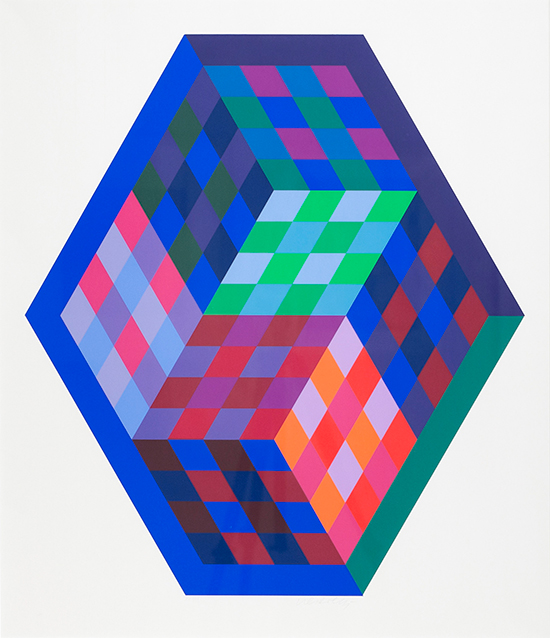
Tridim, edition F.V. 1/18
1969
Serigraph
24 7⁄16 x 22 1⁄16 in.
From the collection of Herakleidon Museum, Athens, Greece
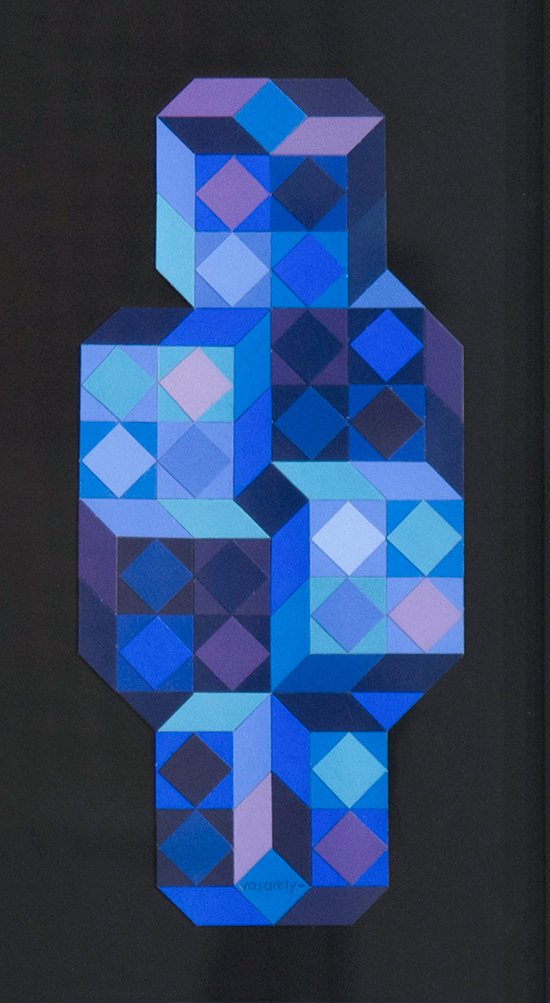
Tridim-G
1968
Collage
13 x 5 15⁄16 in.
From the collection of Herakleidon Museum, Athens, Greece
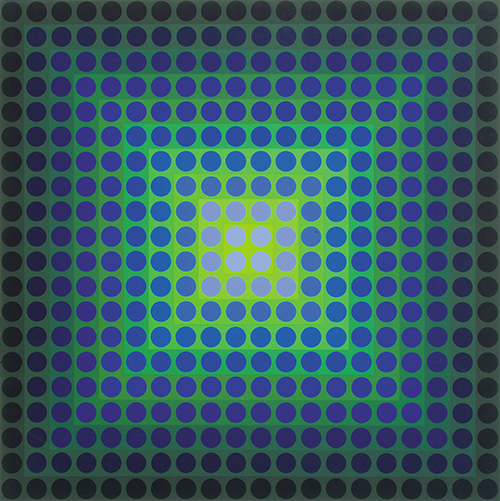
CTA 25 BF (Portfolio Permutations), edition F.V. 7/24
1968, created in 1965
Serigraph
23 5⁄8 x 23 5⁄8 in.
From the collection of Herakleidon Museum, Athens, Greece
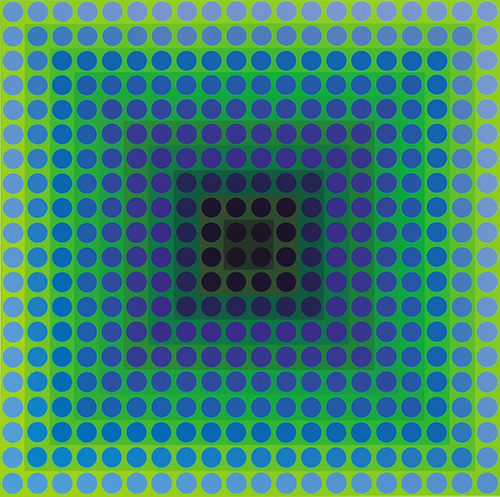
CTA 25 BC (Album Permutations), edition F.V. IX/L 6/43
1968, created in 1965
Serigraph
23 5⁄8 x 23 5⁄8 in.
From the collection of Herakleidon Museum, Athens, Greece
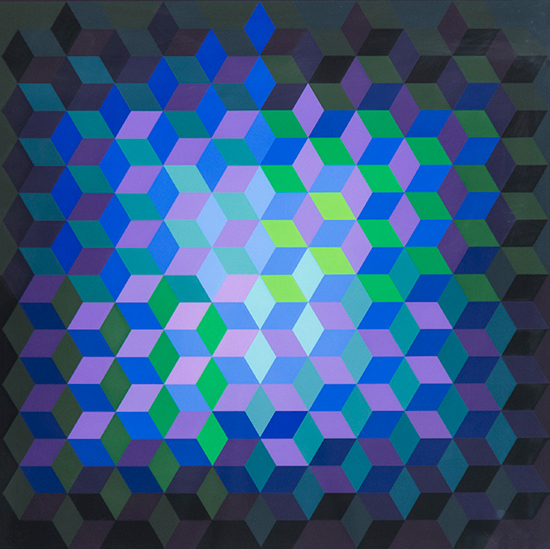
Ion (Portfolio Hommage à l’Hexagone), edition F.V. 9/37
1969, created in 1964
Serigraph
23 ¾ x 23 ¾ in.
From the collection of Herakleidon Museum, Athens, Greece
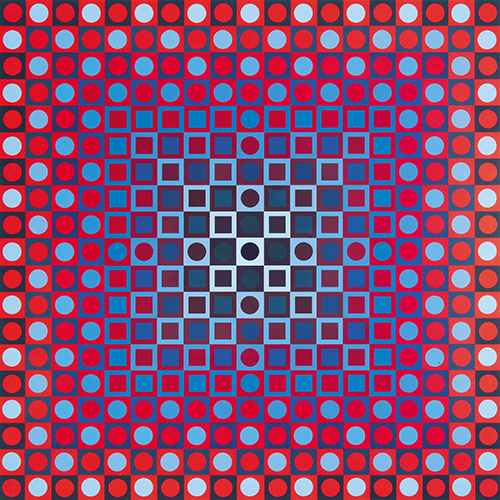
Alom Rouge, edition 43/150
1968, created in 1966
Serigraph
23 5⁄8 x 23 5⁄8 in.
From the collection of Herakleidon Museum, Athens, Greece
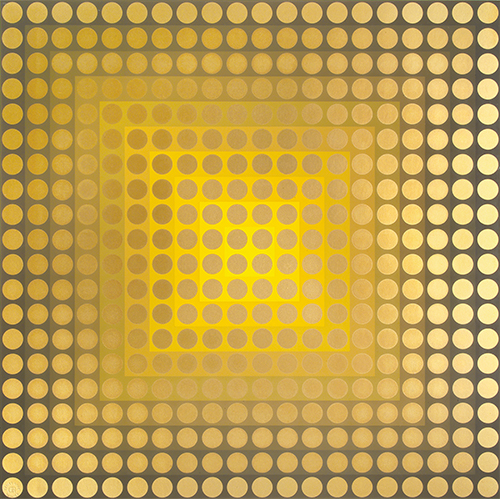
Taller-Or (Album Permutations), edition 79/150
1968
Serigraph
23 5⁄8 x 23 5⁄8 in.
From the collection of Herakleidon Museum, Athens, Greece
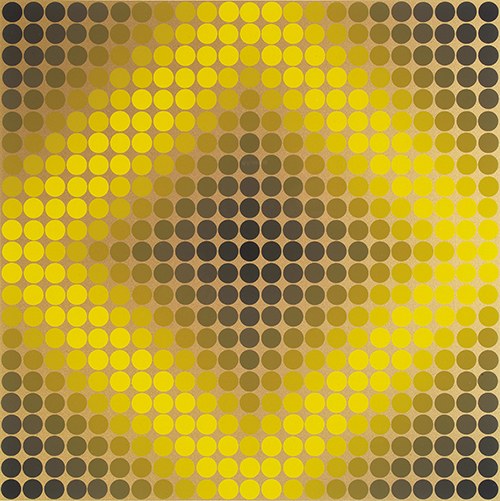
Série CTA, edition 1/250
1966
Serigraph
15 ½ x 15 ½ in.
From the collection of Herakleidon Museum, Athens, Greece
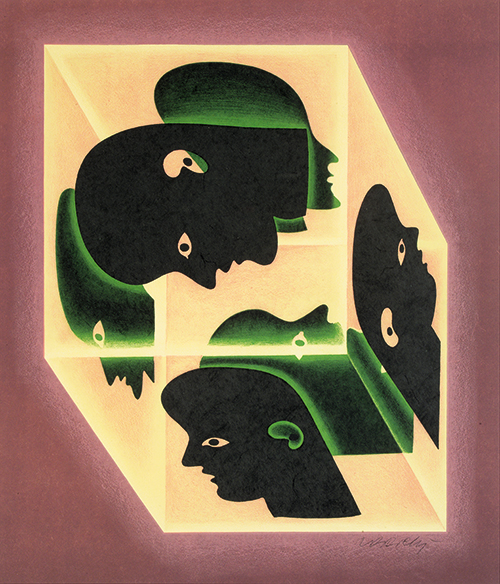
Axonometrie
1969, created in 1937
Serigraph
17 11⁄16 x 15 3⁄8 in.
From the collection of Herakleidon Museum, Athens, Greece
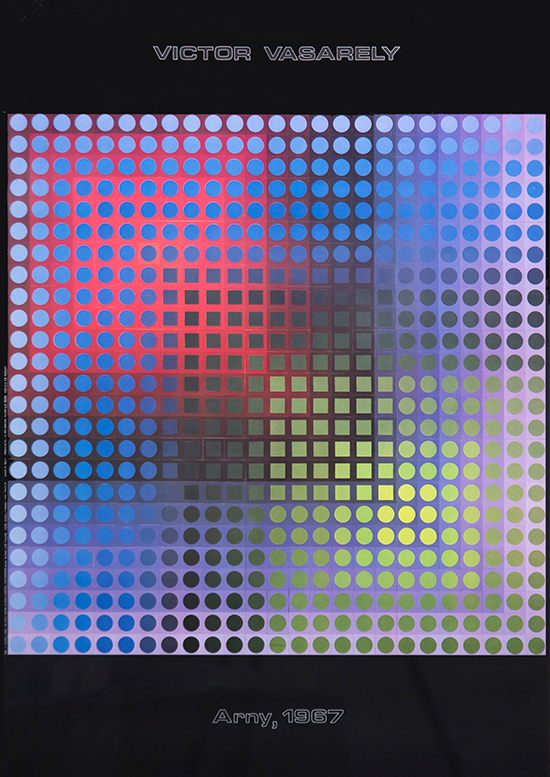
Arny, 1967
1967
33 7⁄8 x 24 in.
Poster
Collection of the World Chess Hall of Fame
1970s
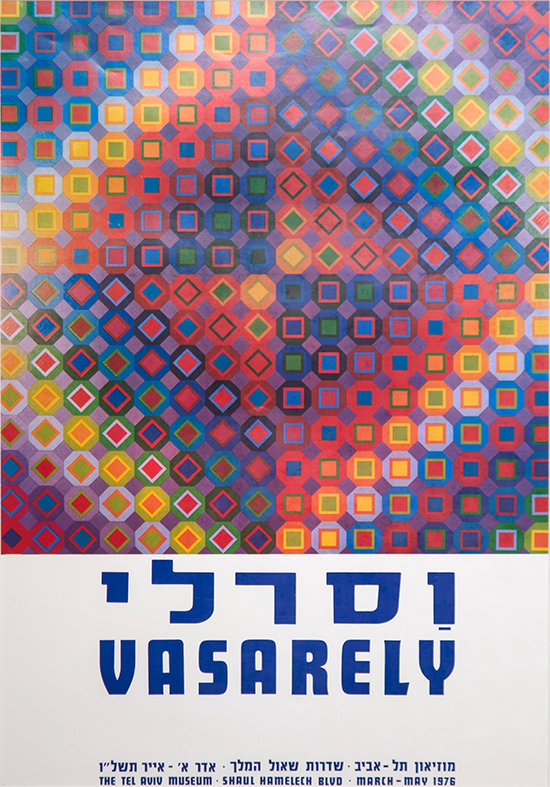
United Artists ltd, Israel Poster
March-May 1976
26 ¾ x 19 in.
Poster
Collection of the World Chess Hall of Fame
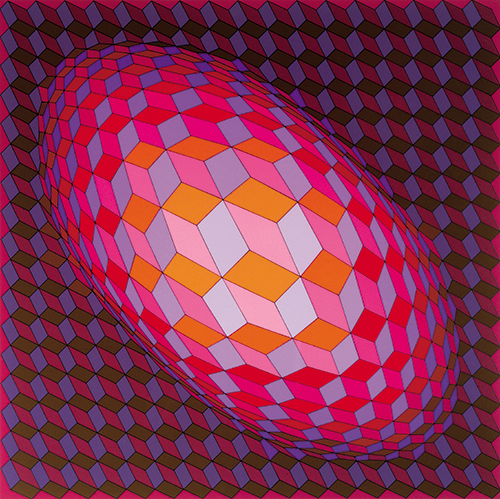
Andromède, edition E.A. 14/25
1978
Serigraph
19 ¾ x 19 ¾ in.
From the collection of Herakleidon Museum, Athens, Greece
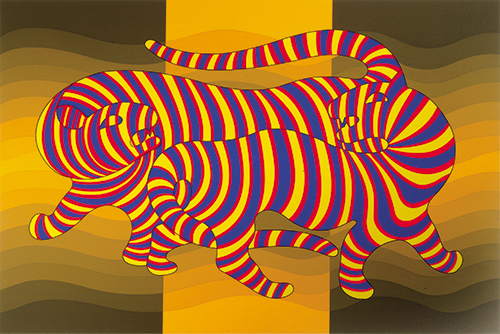
Tigres, edition 70/250
1977
Serigraph
17 5⁄16 x 26 in.
From the collection of Herakleidon Museum, Athens, Greece
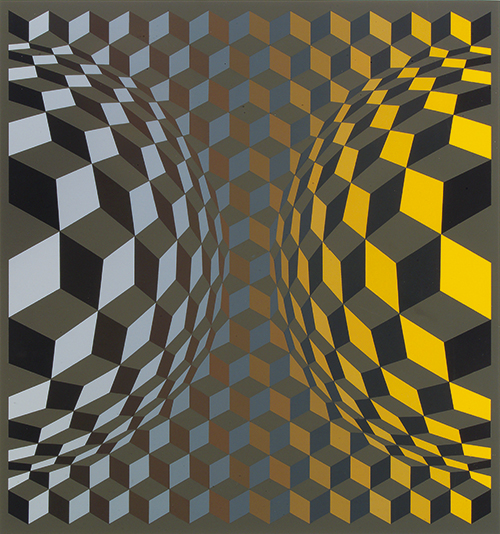
Cheyt-Ond, edition F.V. 3/16
1971
Serigraph
20 ½ x 18 15⁄16 in.
From the collection of Herakleidon Museum, Athens, Greece
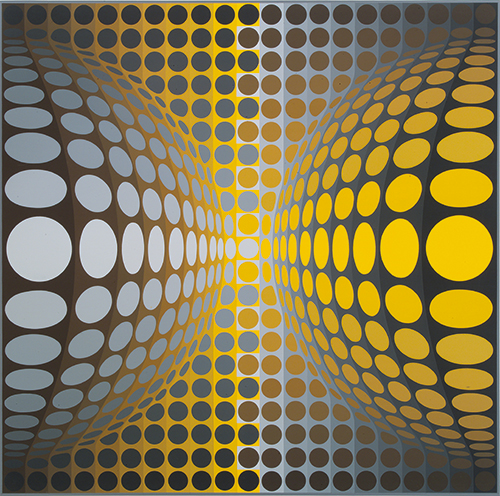
Ond-J.B, edition 97/261
1971
Serigraph
23 7⁄16 x 23 7⁄16 in.
From the collection of Herakleidon Museum, Athens, Greece
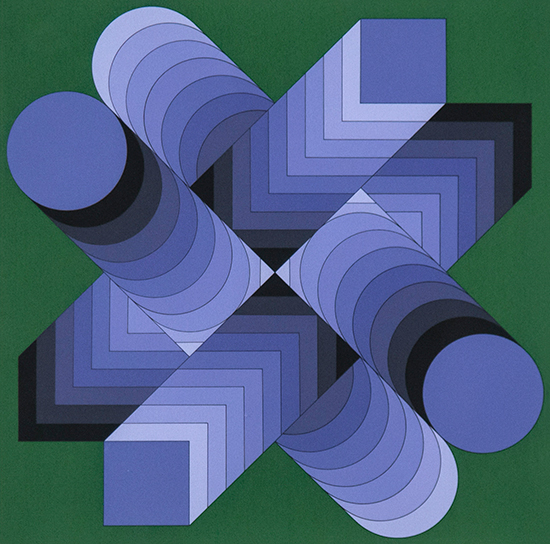
Sees, edition F.V. 82/125
1979
Serigraph
17 11⁄16 x 17 11⁄16 in.
From the collection of Herakleidon Museum, Athens, Greece
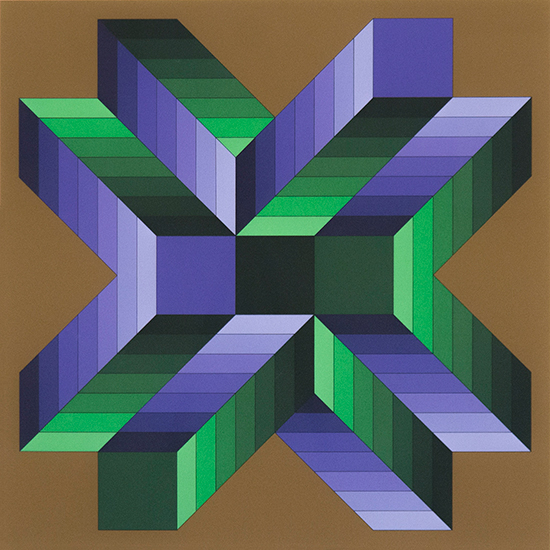
Mata-Fem, edition 145/250
1978
Serigraph
22 1⁄16 x 22 1⁄16 in.
From the collection of Herakleidon Museum, Athens, Greece
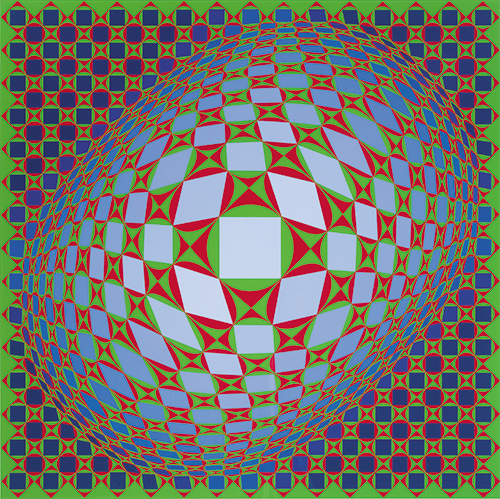
Vilag, edition 225/275
1978
Serigraph
23 5⁄8 x 23 5⁄8 in.
From the collection of Herakleidon Museum, Athens, Greece
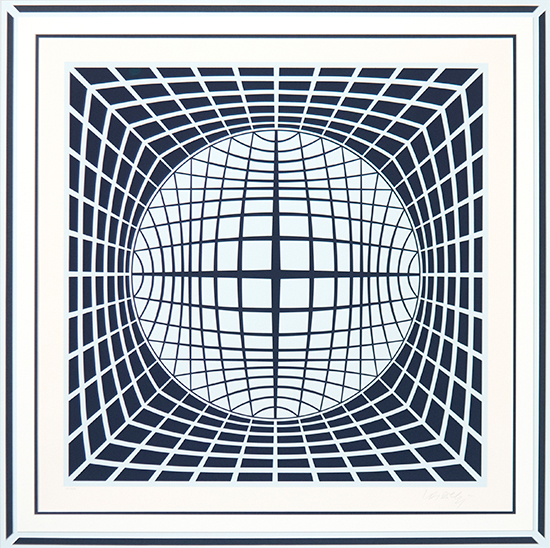
Ter-Ur, edition 106/250
1979
Serigraph
24 7⁄16 x 24 7⁄16 in.
From the collection of Herakleidon Museum, Athens, Greece
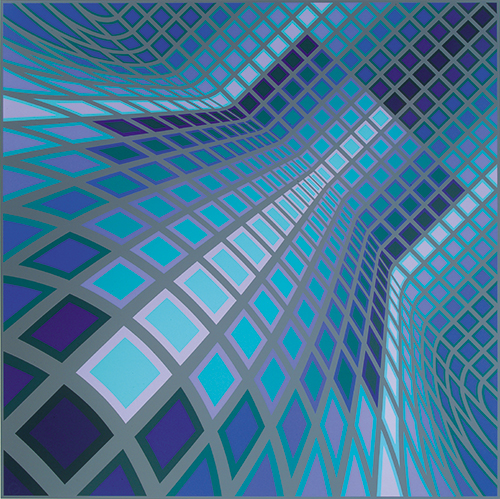
Vertche II, edition 32/250
1978
Serigraph
31 1⁄8 x 31 1⁄8 in.
From the collection of Herakleidon Museum, Athens, Greece
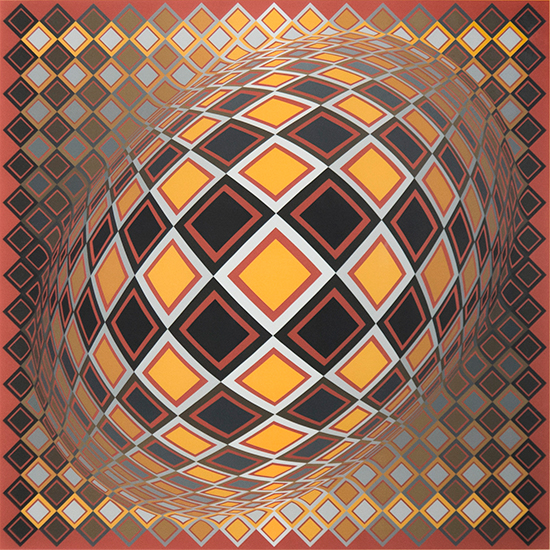
Teke, edition 87/250
1978
Serigraph
26 x 26 in.
From the collection of Herakleidon Museum, Athens, Greece
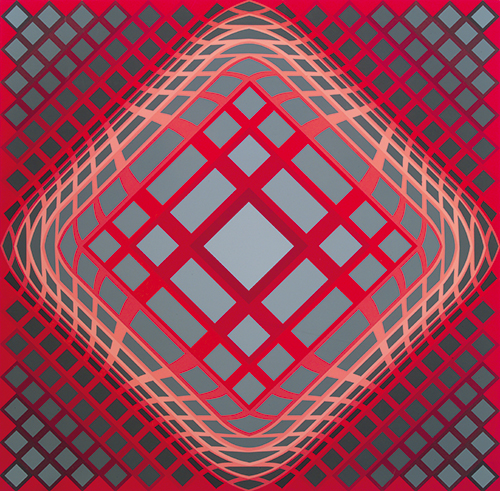
Dell-Surk (portfolio Gaia), edition 233/250
1975
Serigraph
29 9⁄16 x 29 9⁄16 in.
From the collection of Herakleidon Museum, Athens, Greece
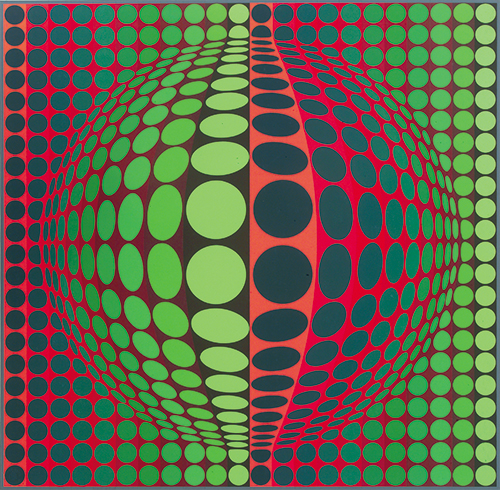
Vega-Fel-VR, edition 40/267
1971, created in 1968
Serigraph
22 13⁄16 x 22 13⁄16 in.
From the collection of Herakleidon Museum, Athens, Greece
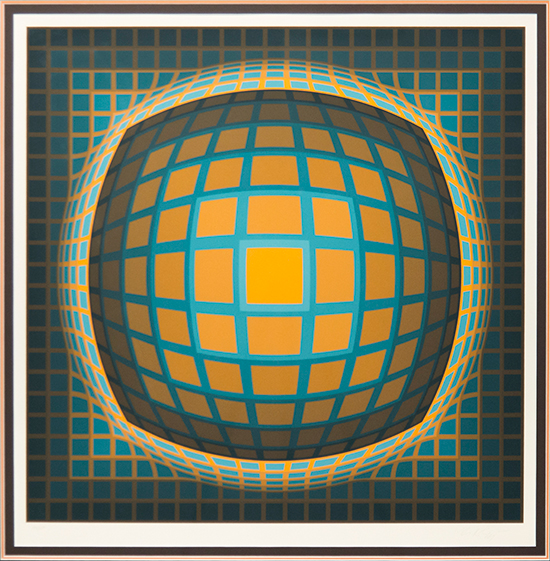
Vega-Pok (from portfolio Enigmes, 1974), edition 173/250
1974
Serigraph
25 11⁄16 x 25 11⁄16 in.
From the collection of Herakleidon Museum, Athens, Greece
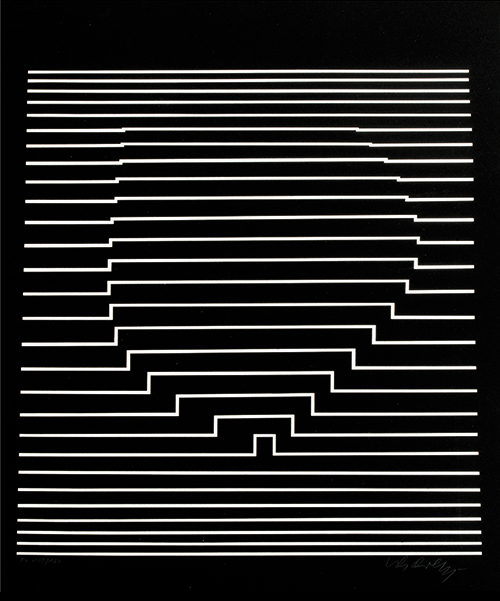
Ilile II, edition F.V. 109/120
1973
Serigraph
18 5⁄16 x 17 5⁄16 in.
From the collection of Herakleidon Museum, Athens, Greece
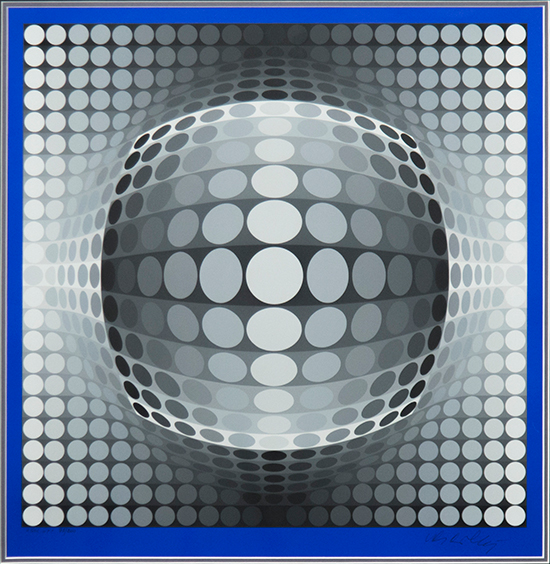
Sol-Ut, edition 98/200
1973
Serigraph
19 x 19 in.
From the collection of Herakleidon Museum, Athens, Greece
1980s & 90s
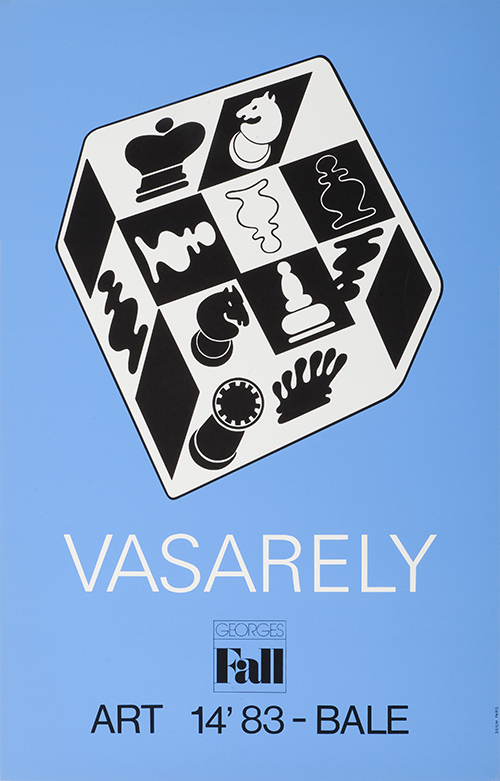
Art 14’ 83 - Bale. Georges Fall
1983
24 ¾ x 15 ¾ in.
Lithograph
Collection of the World Chess Hall of Fame
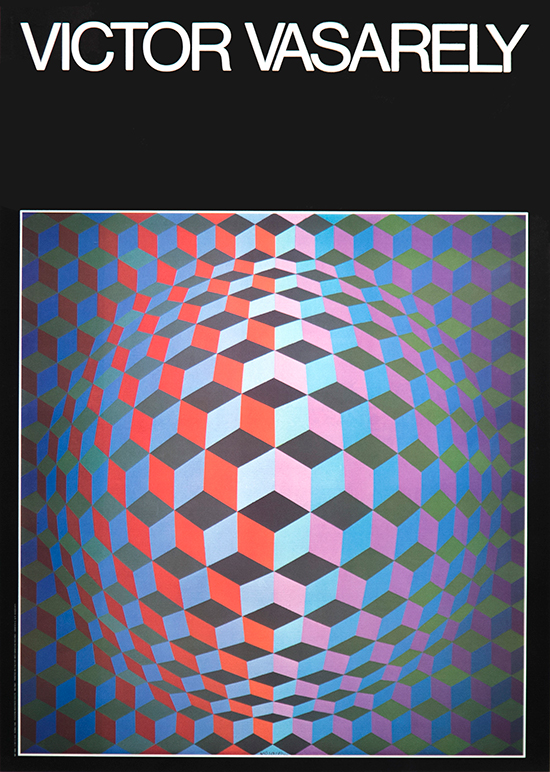
Vasarely Exhibition Poster, Cheyt-G
1986
33 ¾ x 24 in.
Poster
Collection of the World Chess Hall of Fame
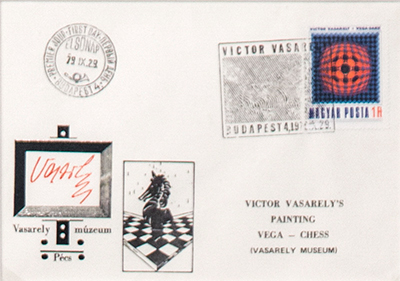
Envelope with Stamps from the Vasarely Museum
1979
4 11⁄16 x 6 5⁄8 in.
Envelope
Collection of the World Chess Hall of Fame
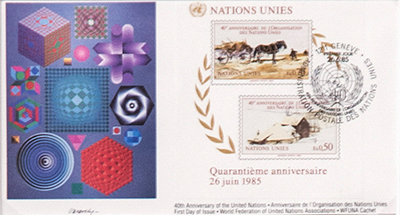
Envelope Celebrating the 40th Anniversary of the United Nations
June 26, 1985
3 9⁄16 x 6 3⁄8 in.
Envelope
Collection of the World Chess Hall of Fame
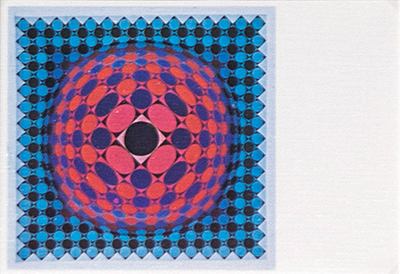
Vega-chess-2 Postcard
1968-1969
4 1⁄8 x 5 13⁄16 in.
Postcard
Collection of the World Chess Hall of Fame
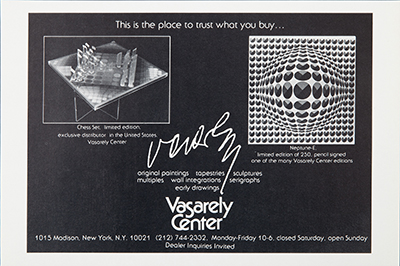
Vasarely Center Advertisement
1979
5 7⁄16 x 8 3⁄16 in.
Advertisement
Collection of the World Chess Hall of Fame
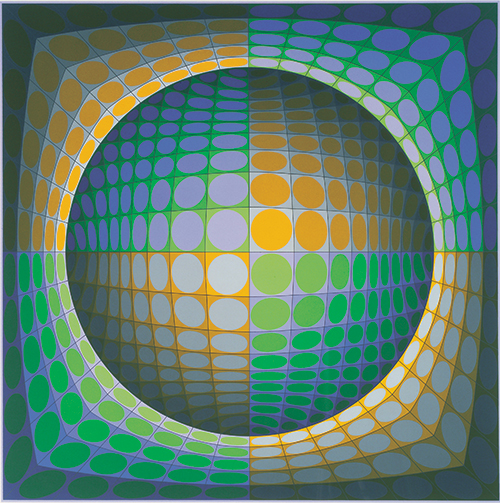
Dirac, edition 74/250
1988
Serigraph
20 x 20 in.
From the collection of Herakleidon Museum, Athens, Greece

Vertigo, edition 155/325
1982
Serigraph
18 11⁄16 x 18 11⁄16 in.
From the collection of Herakleidon Museum, Athens, Greece
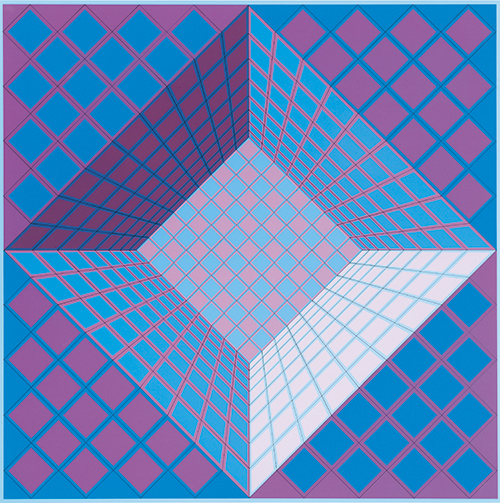
Pictor, edition 145/250
1981
Serigraph
24 7⁄16 x 24 7⁄16 in.
From the collection of Herakleidon Museum, Athens, Greece
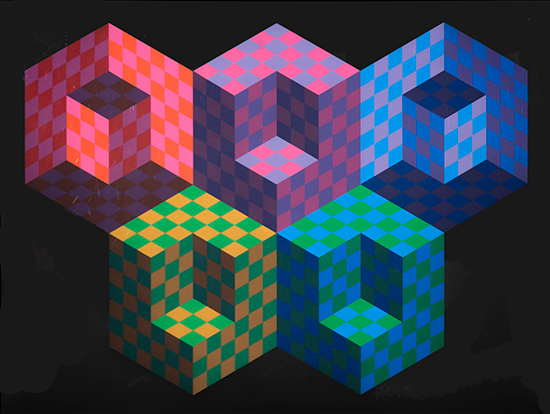
Hexa-5 (Official Arts Portfolio of the XXIVth Olympiad, Seoul), edition CCXXIX/CCC
1988
Serigraph
26 3⁄16 X 35 3⁄8 in.
From the collection of Herakleidon Museum, Athens, Greece
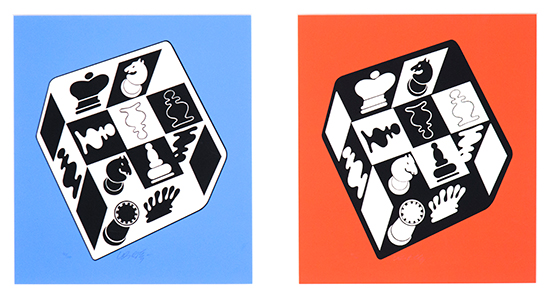
Echecs (fond bleu), edition 40/100
Echecs (fond rouge), edition 85/100
1983
Serigraph
14 3⁄16 x 12 3⁄16 in.
From the collection of Herakleidon Museum, Athens, Greece
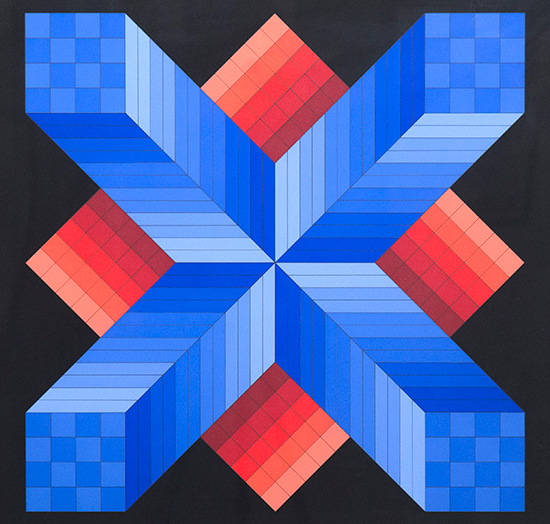
Vallas (portfolio Vancouver, 1982), edition E.A.V. IV/V
1982
Serigraph
24 7⁄16 x 25 9⁄16 in.
From the collection of Herakleidon Museum, Athens, Greece
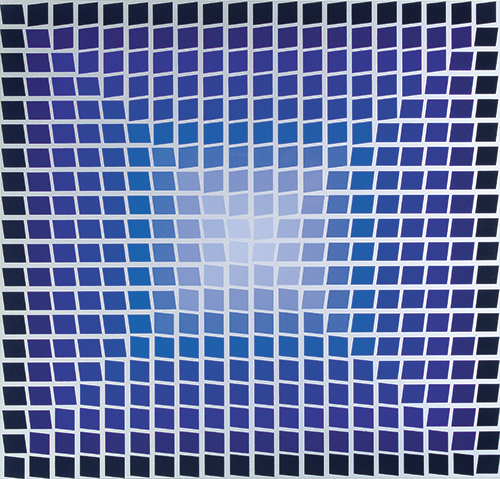
Série CTA, edition 1/250
1980
Serigraph
15 9⁄16 x 15 9⁄16 in.
From the collection of Herakleidon Museum, Athens, Greece
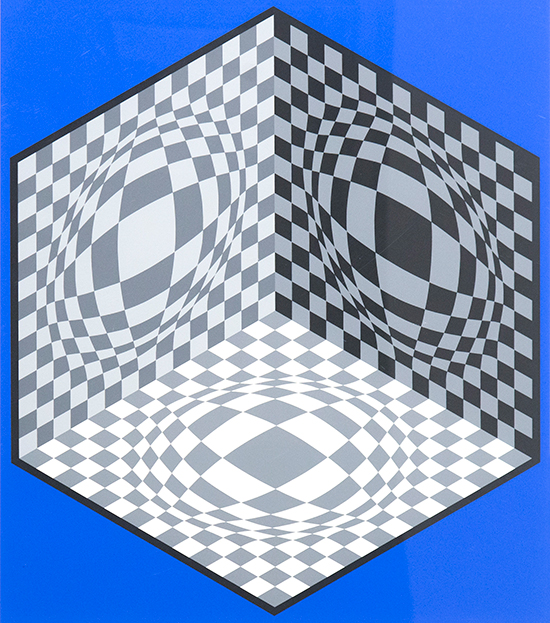
Cubic Relationship, edition 100/325
1982
Serigraph
21 13⁄16 x 19 5⁄16 in.
From the collection of Herakleidon Museum, Athens, Greece
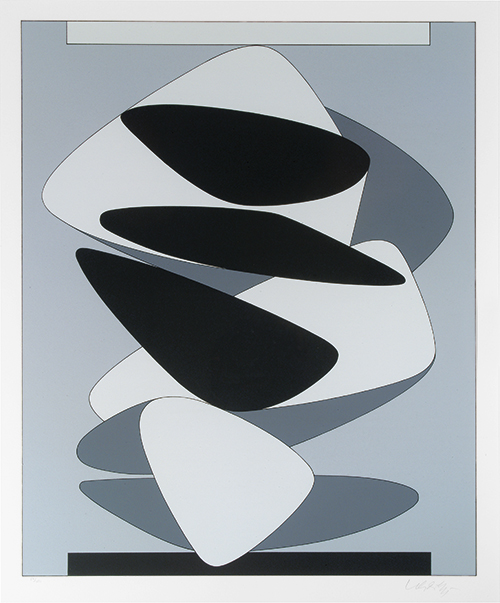
Kervilahuen, edition 17/250
1985
Serigraph
24 x 19 11⁄16 in.
From the collection of Herakleidon Museum, Athens, Greece
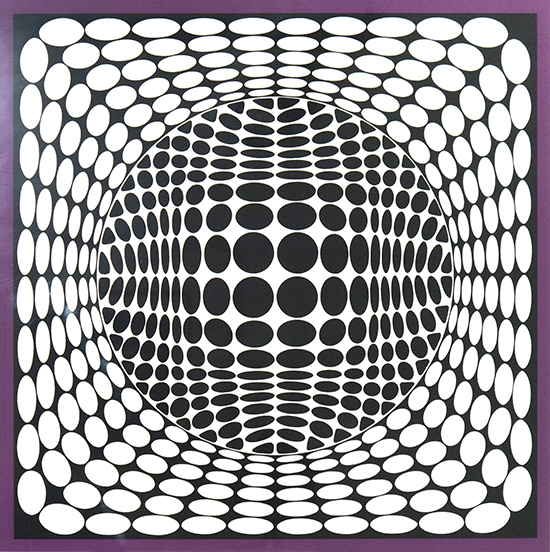
Ter-Ur-NB, edition F.V. 77/140
1984
Serigraph
18 15⁄16 x 18 13⁄16 in.
From the collection of Herakleidon Museum, Athens, Greece
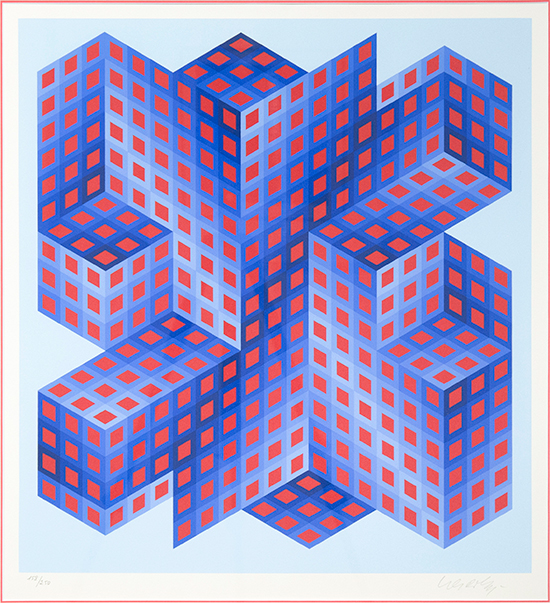
Sinvilag (portfolio Diam, 1988), edition 158/250
1988
Serigraph
22 3⁄8 x 20 11⁄16 in.
From the collection of Herakleidon Museum, Athens, Greece
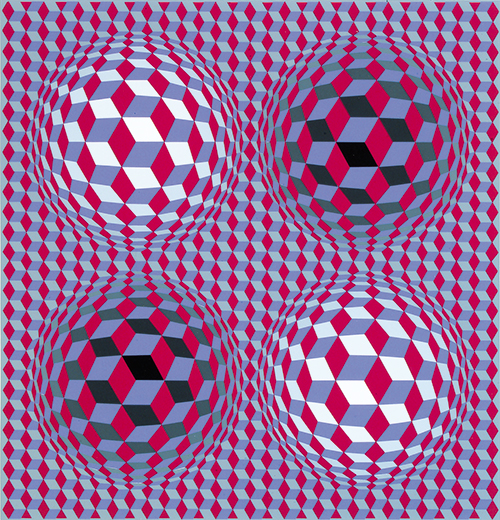
Deimos, edition VII/XXX
1981
Serigraph
12 5⁄16 x 11 13⁄16 in.
From the collection of Herakleidon Museum, Athens, Greece
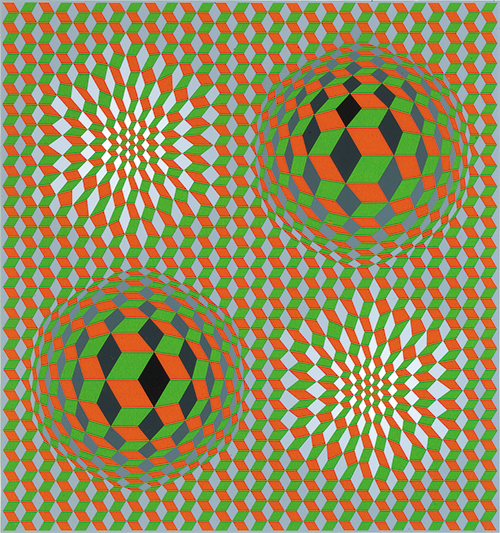
Métagalaxie, edition 33/250
1981
Serigraph
12 5⁄8 x 11 13⁄16 in.
From the collection of Herakleidon Museum, Athens, Greece
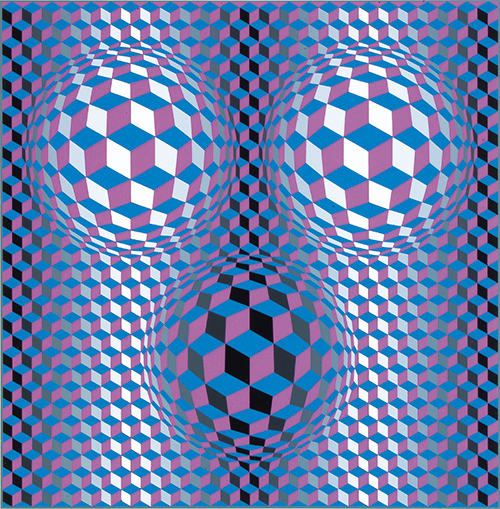
Callisto, edition 34/250
1981
Serigraph
12 ¼ x 11 15⁄16 in.
From the collection of Herakleidon Museum, Athens, Greece
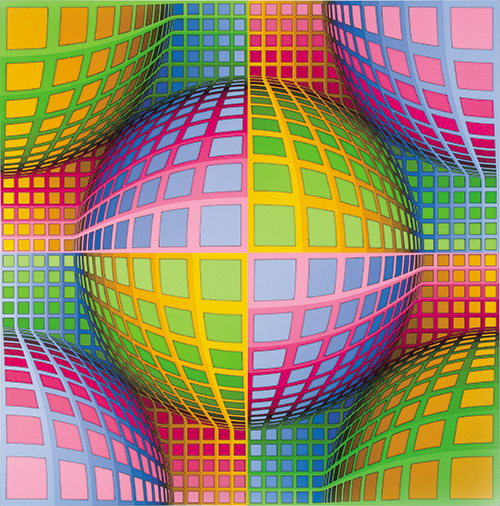
Rivotril, edition 49/300
1990
Serigraph
26 1⁄8 x 26 1⁄8 in.
From the collection of Herakleidon Museum, Athens, Greece
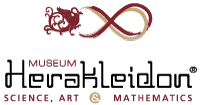
Vasarely works from the collection of Herakleidon Museum, Athens, Greece www.herakleidon-art.gr
 Full Caption:
Full Caption:
One Source Exhibition provided by Pan Art Connections Inc.

Financial assistance has been provided by the Missouri Arts Council, a state agency.
Press
1/18/2018: St. Louis Public Radio — On Chess: The role of chess in the creation of the op art movement
10/16/2017: HEC-TV — Fashion, Optical Art & Chess at the World Chess Hall of Fame (video)
10/16/2017: KSDK — New exhibits open at World Chess Hall of Fame (video)
10/13/2017: St. Louis Magazine — Slideshow: Opening Reception for "Pinned!" and "Calculated Compositions" at the Chess Hall of Fame
9/12/2017: Victor Vasarely: Calculated Compositions Exhibition Press Release
